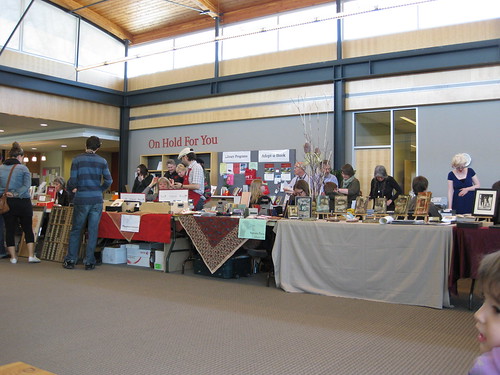May 3, 2011
My Weekend in Grimsby
Can I just say, Grimsby is a beautiful little town! I’m jealous of anyplace that gets a proper green, flowered spring, and such a spring was certainly on display Saturday when we visited for the the 33rd Annual Wayzgoose. The atmosphere was warm, cheerful and tastefully tactile.
As a bonus, the Grimsby Public Art Gallery was also displaying The Nature of Words, a travelling exhibit of book-related art. I saw this show when it debuted in Toronto and wasn’t completely captivated by it. The artists represented were top-notch book artists in their various fields (binders, printers, paper makers and so on) but the focus of the exhibit was on words rather than the means of transmitting those words. The result was a lot of out-of-context prints, banners and fragments which failed (in my opinion) to show the best of what these accomplished book makers could do.
However, in Grimsby the artists and presses who participated in The Nature of Words had their booths in the gallery, and finally visitors could see the really stunning work in book form that they produce. These were among my favourite offerings of the show – Will Rueter’s Aliquando Press had nearly their entire catalogue on hand and I was totally taken by the lovely work Locks’ Press had on offer. Binder Don Taylor’s booth had some design bindings on hand as well as smaller pamphlets from his Pointyhead Press. If The Nature of Words had originally contained more of these press’s books and less “art”, I might have enjoyed it more the first time around!
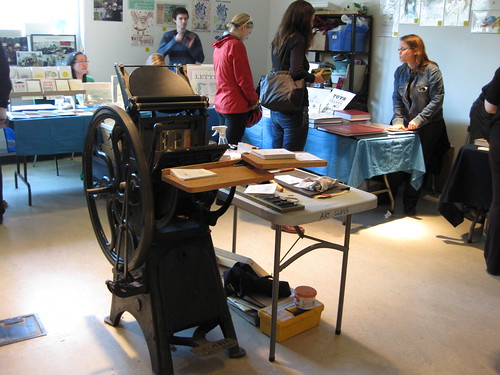 But not everybody – not even book arts followers – are as fixated on books themselves as I am, and the rest of the show featured as many if not more presses and artists who work outside of the codex form. There was a glut of cards, bookmarks, prints and posters, coasters and other paper-based curios. This makes for incredible shopping, regardless of your interest! It’s far too easy to spend $2-$10 at every single booth in the show buying some beautifully printed bit of ephemera or another. Which I did, I think. How could I not? My favourite ephemeral offering? Grocery lists from the Mackenzie Heritage Printery & Newspaper Museum:
But not everybody – not even book arts followers – are as fixated on books themselves as I am, and the rest of the show featured as many if not more presses and artists who work outside of the codex form. There was a glut of cards, bookmarks, prints and posters, coasters and other paper-based curios. This makes for incredible shopping, regardless of your interest! It’s far too easy to spend $2-$10 at every single booth in the show buying some beautifully printed bit of ephemera or another. Which I did, I think. How could I not? My favourite ephemeral offering? Grocery lists from the Mackenzie Heritage Printery & Newspaper Museum:
I wish I could say I restricted my buying to tiny and affordable curios, but I did not. I couldn’t leave without this year’s Wayzgoose Anthology. These books contain one signature (a folded sheet) from each of the exhibitors. The final product is a strange mish-mash of beautifully printed poems and essays, lithographs and woodcuts, fold-out maps, hand-coloured drawings, collages and handbills. I would estimate that 100-130 of these were printed and bound, the majority of which go to the exhibitors. I NEEDED TO HAVE ONE.


Some of my Wayzgoose pages...
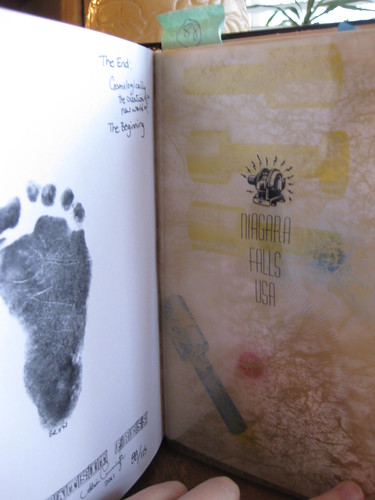
More Anthology pages...
April 25, 2011
Things to do this weekend: Wayzgoose!
 I couldn’t possibly be more excited about this weekend, because for the first time in years I will be traveling outside of Toronto exclusively for a bookish event: the 33rd Annual Wayzgoose in Grimsby, Ontario.
I couldn’t possibly be more excited about this weekend, because for the first time in years I will be traveling outside of Toronto exclusively for a bookish event: the 33rd Annual Wayzgoose in Grimsby, Ontario.
There are a lot of bookish events in Ontario, but this is the only one I can think of dedicated specifically to the “Book Arts” rather than, say, publishing, reading, or rare/used books. That’s probably why they now boast attendance of upwards 2000 people from all over the world – this isn’t exactly an opportunity to sell books or schmooze so much as it’s a genuine festival, a celebration of the arts that bring you printed books: letterpress printing, paper making, bookbinding, marbling, calligraphy and more. I look forward to demonstrations and displays as well as the opportunity to spend money on one-of-a-kind books from odd and out-of-the-way bookmakers.
I started this post, by the way, with the impression that the Wayzgoose was founded and hosted by Erin, Ontario’s Porcupine’s Quill Press, but after some research I discover this is not the case. The Wayzgoose is entirely independent, officially sponsored by the Grimsby Public Art Gallery. My confusion probably stems from the fact that Porcupine’s Quill is enormously supportive of the endeavor, especially as they publish Canada’s only dedicated Book Arts journal, the Devil’s Artisan. It is through Porcupine’s Quill that I learned of the event and because of their cheerleading that I am so psyched about the event – and probably also because of one or two excellent wares they promise to have available: a new issue of D.A. and a new facsimile edition of George Walker’s Alice’s Adventures in Wonderland.
And to wander further off on a tangent, Porcupine’s Quill seems to be making a stab at replacing Gaspereau Press as the country’s most talked-about craft press – not only are they running a social-media contest right now to promote Alice’s Adventures, but I spotted their little ad in the print edition of this weekend’s Globe and Mail books pages. I choose to interpret this as evidence of a surge of interest in the book arts. Who’s with me?
Well nevermind, but I will be in Grimsby on Saturday, and I hope some of you will be to!
April 18, 2011
Objects Found in Books
One of my favourite bookish news stories from the last month is this one in which a typed letter from Robertson Davies to New Canadian Library co-founder Malcolm Ross was found in the pages of a book bought at a Halifax Salvation Army shop for $1. This kind of thing actually happens all the time, though perhaps not so often with such bright lights of Canadian literary history. From as far back as books have been produced in codex-form, people have been putting flattish things in between the pages and have forgetting them there. One of the great pleasures of buying second-hand books is finding them again.
Sometimes this kind of ephemera can be quite valuable to collectors and to libraries, a hunger wonderfully novelized by A.S. Byatt in Possession. More often it is simply another layer of history passed down through the object to the new reader. Old bookmarks, receipts, notes and letters; even pressed flowers, locks of hair and ribbons give a used book a unique character that separates it from other copies of the same book. Even this can be of value to a book history scholar (again, beautifully novelized by Geraldine Brooks in her recent People of the Book), but personally I love the way it gives me my own mystery to solve; good for nothing, probably, but telling a story.
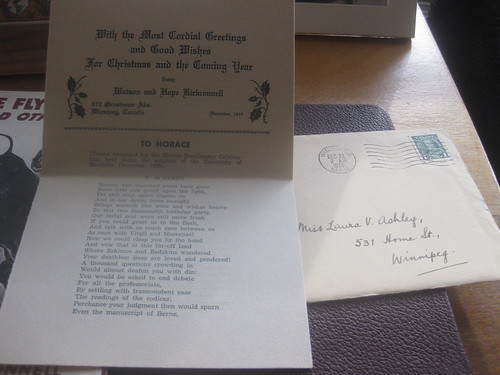 Two great-aunts of mine, both spinster librarians who kept up friendly correspondence with writerly contemporaries of theirs, were great clippers and hoarders. Few books I’ve inherited from them are free from newspaper clippings, letters and photocopied notes from other books. An old biography of Rudyard Kipling contains clipped Kipling poetry from a 1920s newspaper, while my facsimile of John Gerard’s 1633 Herbal has notes on the authors photocopied from the Oxford Dictionary of National Biography.
Two great-aunts of mine, both spinster librarians who kept up friendly correspondence with writerly contemporaries of theirs, were great clippers and hoarders. Few books I’ve inherited from them are free from newspaper clippings, letters and photocopied notes from other books. An old biography of Rudyard Kipling contains clipped Kipling poetry from a 1920s newspaper, while my facsimile of John Gerard’s 1633 Herbal has notes on the authors photocopied from the Oxford Dictionary of National Biography.
One aunt in particular seems to have been a friend of the Western Canadian author Watson Kirkconnel. One of my favourite ephemeral findings is a Christmas card, sent in 1935, from Kirkconnel and his wife featuring a poem, “To Horace”, otherwise unpublished. Though Kirkconnel is utterly unknown and out of print today, the addition of this cheerful little relic of the past makes this book (a limited edition copy of his Flying Bull and Other Stories) one of my favourites. Kirkconnel has posthumously become an imaginary family friend, part of my own past. Other letters and clippings from Kirkconnel adorn other books in my library: I like to invent and exaggerate the dimensions of my aunt’s relationship with the once-great author. The artifacts give me that right, I think.
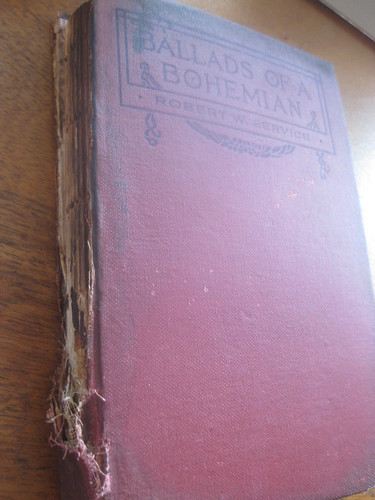 Once when I was very young I snuck into a broken-down house known to me in order to “liberate” a very musty and dilapidated old tome I saw there. I imagined that, being an old broken-down house, all printed materials found within must necessarily be mysterious, valuable, and possibly occult. I was both very wrong and very right. The book, Robert Service’s Ballads of a Bohemian, is utterly worthless because of the condition it is in – torn, moldy, and even slightly burnt-up. On the other hand, it appears to contain a slip of paper bearing Service’s signature. The book is not signed directly, but the name is written on a separate slip found facing the portrait of the author. Is it really the author’s signature? I have no idea. It is not a clean and tidy signature, and looks instead to have been made by someone very advanced in years, or in deteriorating health. That said, that nearly rules out its being a copy or forgery. Any attempt to mislead would surely be closer to the “official” thing. But why else would it be there? This is my bookish mystery. The myth associated with my finding and retrieving this book certainly sounds better if the tale ends with its being a signed copy. Well, it’s my unique relic so, again, I reserve the right to tell the story. It’s signed, my own treasure.
Once when I was very young I snuck into a broken-down house known to me in order to “liberate” a very musty and dilapidated old tome I saw there. I imagined that, being an old broken-down house, all printed materials found within must necessarily be mysterious, valuable, and possibly occult. I was both very wrong and very right. The book, Robert Service’s Ballads of a Bohemian, is utterly worthless because of the condition it is in – torn, moldy, and even slightly burnt-up. On the other hand, it appears to contain a slip of paper bearing Service’s signature. The book is not signed directly, but the name is written on a separate slip found facing the portrait of the author. Is it really the author’s signature? I have no idea. It is not a clean and tidy signature, and looks instead to have been made by someone very advanced in years, or in deteriorating health. That said, that nearly rules out its being a copy or forgery. Any attempt to mislead would surely be closer to the “official” thing. But why else would it be there? This is my bookish mystery. The myth associated with my finding and retrieving this book certainly sounds better if the tale ends with its being a signed copy. Well, it’s my unique relic so, again, I reserve the right to tell the story. It’s signed, my own treasure. 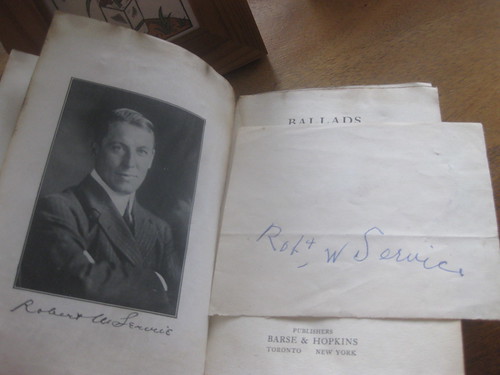
To beat that poor old horse, it would be a real shame if the digital future inadvertently limited or destroyed the preservation of ephemera. Casual insertion of things into day-to-day books has brought a wealth of everyday artifacts to us. It goes without saying that nothing can be inserted into an ebook, but moreover, it’s more rare for things to be inserted into valuable or collector books. A theoretical future where the remaining printed books are more highly valued as artifacts is one where people are less likely to stick any old thing between the pages. Casually read books are the ones which come to us with the heaviest signs of their history. I was struck while re-reading Frank Herbert’s Emperor of Dune by a scene in which a high-tech book is stolen and then, between the pages, a dried flower is found. The discovery is significant to the characters but also oddly anachronistic. Even in the year 13,000 we’re to presume that the book has remained as much a vehicle for material pieces of life as much as of information.
Of course the ephemera itself is disappearing more quickly than the book in any case. Newspapers? Letters? Recipe cards? Relics of past generations moreso than books. But I’ll miss, you know, receipts, bookmarks and flowers. Wouldn’t you?
April 8, 2011
I can YOSS too!
 A bunch of smart and dedicated persons (I hesitate to say “ladies”, but I think they might all be ladies) have declared 2011 to be the Year of the Short Story. Now while I don’t think I am very likely to want to spend a year reading nothing but short stories (which is not, by the way, what they are suggesting), I can’t argue with their aim: to bring short fiction to a larger audience.
A bunch of smart and dedicated persons (I hesitate to say “ladies”, but I think they might all be ladies) have declared 2011 to be the Year of the Short Story. Now while I don’t think I am very likely to want to spend a year reading nothing but short stories (which is not, by the way, what they are suggesting), I can’t argue with their aim: to bring short fiction to a larger audience.
Once upon a time I was a heavy short story reader. I am now a light short story reader. The last anthology I read was I read was Neil Gaiman & Al Sarrantonio’s Stories, which I’d say was a mixed success. It certainly contained a couple stories I just loved (notably Neil Gaiman’s The Truth Is A Cave In The Black Mountains and Michael Moorcock’s Stories), and at least one I want to go back to (Jeffrey Ford’s Polka Dots and Moonbeams). But it also had it’s share of silly, hackneyed stories featuring overdone themes – like Walter Mosley’s Juvenal Nyx (oh good, another angsty, vampire-with-a-soul story) and Joanne Harris’s Wildfire in Manhattan (gods of old WALK AMONG US).
But this is the nice thing about short stories. Even within one collection, you can taste such a variety of persons, places and ideas. They’re easy to dip into and out of, and to go back to. Any collection is bound to have at least one story you’d recommend to a friend, whereas I’m not sure I’d ever recommend a chapter of a book to anyone. They offer a level of accessibility without triviality.
I’ll put my money where my mouth is – per YOSS suggestion #1, I am buying more short stories. And last night, this came in the mail!

Check it out – my Limited Edition (59/300) copy of Machine of Death: A Collection of Stories About People Who Know How They Will Die ed. Ryan North, Matthew Bennardo & David Malki ! I’ll be honest, I don’t know any of the authors, but each story is illustrated by a cartoonist, many of whom I am a big fan of. But no, I didn’t buy it for the pictures. That might have been an excuse (that and the Certificate of Predicted Death), but it’s also a chance for me to sample stories by a variety of writers who I might otherwise never encounter, as recommended to me by cartoonists I trust. And, you know, then there’s the pictures. And the chance to have them all signed next month at TCAF.
The short story world is full of fun gems like this! I hope you’ll seek one or two out this year too. Sometimes the most interesting reads are off the beaten track [of novels]!
April 6, 2011
Upcoming Book Geekery
It’s a quiet time of year here for us at the bookstore, but that means a lot of quiet, intimate time with the publisher catalogues. A dangerous time of year, as you can imagine. I am additionally imperiled by the fact that I will be on maternity leave by mid-July this year, and so I’m feeling a need to pre-order all kinds of things before I’m “out of the loop” for a year, as it were.
What kinds of things? Well.
 Titus Awakes by Mervyn Peake & Maeve Gilmore
Titus Awakes by Mervyn Peake & Maeve Gilmore
I’m skeptical about works published post-humously, generally. Especially things possibly never intended for publication based on “manuscripts” or worse still “fragments” found years later by family members.
The circumstances surrounding this books “discovery” are also a bit suspect. Peake’s widow, Maeve Gilmore, wrote or finished a manuscript based on Peake’s notes in the 1970s, but the manuscript was “lost”. In 2010 the manuscript was “found” in a family attic – just in time for Peake’s centenary! Convenient, no?
Even still, Mervyn Peake’s Gormenghast trilogy (now, apparently, a tetrology) is one of my most beloved works of literature, and I can’t resist more.
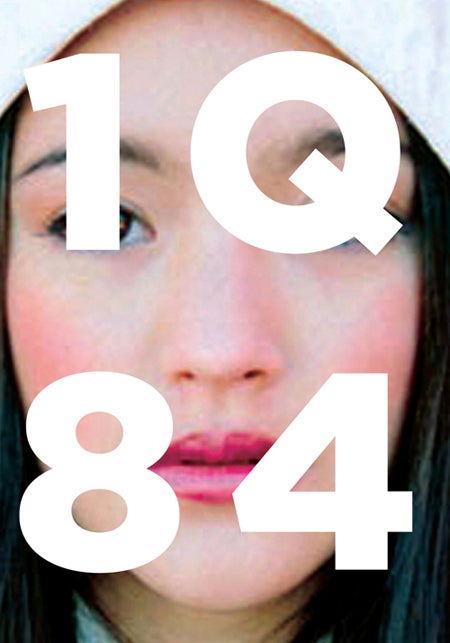 1Q84 by Haruki Murakami
1Q84 by Haruki Murakami
How can anyone not be excited about a new Murakami novel? Goodness knows the Japanese lost their minds over it, apparently buying up almost 450,000 copies of the first volume (it was published in three parts in Japanese) before it was even published.
I adored Kafka on the Shore and Wind-Up Bird Chronicle. I tend to use the term “postmodern” disdainfully, but I’m a complete hypocrite – in reality many of my favourite modern novels are way out on the wacky fringe of postmodern surrealism – Nabokov’s Pale Fire, Murakami, Rushdie, Marquez. That 1Q84 is being described as Murakami’s “magnum opus”, and “a mandatory read for anyone trying to get to grips with contemporary Japanese culture” just adds to the appeal. 1000 pages plus of a “complex and surreal” narrative? Sign me up!
 Il Cimitero di Praga by Umberto Eco
Il Cimitero di Praga by Umberto Eco
Okay, this one’s a bit cheaty because what I’m really looking forward to is the eventual (and inevitable) English translation, The Cemetery of Prague, which hasn’t been published yet.
The story of the genesis and history of the Protocols of the Elders of Zion is a great one for book history lovers. In Umberto Eco’s hands, it’s a tale of intrigue and conspiracy. The book has come under some criticism for blurring some lines between genuine antisemitism and fictional antisemitism, but I don’t personally believe for one second that Eco is genuinely antisemitic. He has said: “I’m interested in recounting how through the accumulation of these stereotypes the ‘Protocols’ were constructed. [..] My intention was to give the reader a punch in the stomach.” and I believe him.
That the plot of Alexandre Dumas’s Joseph Balsamo also plays a large part in the plot of this novel is also a HUGE draw. Surprise!
How imminent is an English translation? No idea! But I refuse to miss it just because I’m sitting at home with my kids.
 Climate Capitalism: Capitalism in the Age of Climate Change by L. Hunter Lovins & Boyd Cohen
Climate Capitalism: Capitalism in the Age of Climate Change by L. Hunter Lovins & Boyd Cohen
I’ve mentioned I’m an environmentalism nerd, right? One of Hunter Lovins’s previous books, Natural Capitalism, pretty near changed my life. And true story: it was for some time my life’s ambition to work in carbon trading. You know, where companies can buy and sell carbon credits under a cap-and-trade system. Okay, maybe a little obscure for the book crowd.
In any case, the environment might not be the biggest hot political topic of the minute anymore, but I assure you the problems didn’t fix themselves when we lost interest again. This year has actually been a wonderful year for good, readable books on the current and future movements in environmentalism – Tim Flannery’s (most famous for The Weather Makers, but who is also responsible for a fabulous illustrated bestiary of extinct animals called A Gap in Nature) new book Here On Earth also just hit shelves, and Ray Anderson’s Confessions of a Radical Industrialist is at the very top of my must-read pile. I’m happy to report that the serious discussion about climate change has moved beyond fear mongering vs deniers, and is in the happier territory of Okay But What Can We Do, Realistically. I love this territory. I’m a big one for plans of attack.
 Hark! A Vagrant by Kate Beaton
Hark! A Vagrant by Kate Beaton
Beaton’s previous collection, self-published and distributed by Topatoco, was more of a sampler; something thrown together to sell at conventions and get the word out. It was silly successful – Beaton won the Doug Wright Award for Best Emerging Talent and has subsequently been published in the Walrus, the New Yorker, The National Post and, I’m sure, more.
No surprise, she’s been picked up by Montreal graphic novel game-changers Drawn & Quarterly. Drawn & Quarterly produce the most beautiful books, and though I expect their Hark! A Vagrant collection will retread a lot of the same material as appeared in Never Learn Anything from History, it’s bound to be better put together in every possible way. If their previous publications are anything to go by, there might even be a limited edition signed/numbered w/ insert edition. Exciting!
I have my little fingers crossed that they might even have some copies ready by TCAF this May – but just in case, my order is in.
Anyone else want to share? Any upcoming releases have you super excited?
April 1, 2011
The Gryphon Lecture on the History of the Book: Digital Reviewing
Last night I attended the 17th annual Gryphon Lecture on the History of the Book for the Friends of the Thomas Fisher Rare Book Library. The lecturer this year was the very prolific and always amazing Prof. Linda Hutcheon speaking on, to my delight, “Book reviewing for a New Age”. Well well!
Though Prof. Hutcheon is an academic and the Thomas Fisher is an institution within the University of Toronto, the Gryphon lecture is intended for a “layman” audience of supporters and friends. Unlike so many talks I’ve attended on book reviewing and the internet, the audience here was entirely devoid of persons employed by the publishing industry. These were readers, heavy ones, and especially, readers of print book reviews. So understandably, much of Hutcheon’s talk was aimed at making a case for digital forms of book reviews, and what they offer to readers.
In this regard, she was not tremendously successful. She began with outlining the decline of the print review, giving us a good history of which papers have scrapped their Books sections and why. The reasons given by the papers and by Hutcheon were all economic: it is no longer, apparently, worth it to a publisher to buy advertising at the same rates and quantities in print. The blame for that has been placed on the internet, probably rightly. The same advertising budget now has to include websites like Amazon.com, the lit blogs and the review copies given out through the thousands of social media channels.
The decline of print reviews has been matched by a much larger increase, however, in digital reviews. All signs point to an overall increase, rather than decrease, in engagement with books. Hutcheon explored at length the “economic, political and ethical” implications of this new divide.
I’ll leap ahead to the end in order to justify my opinion that she ultimately failed to make her case, however: no matter how many good points she made about the value of a more democratic engagement with books, or about increased readerships, the discussion never came full circle to re-include the print reviews. Ideally, she argued, print would broadcast the paid reviewer’s specialty: reviews with a “broader cultural scope”; expansive, reflective articles from persons who (ideally) are more professional and accountable than the customer-reviewer of the internet. Which sounds like a brilliant idea, but it doesn’t explain how this is going to be paid for. If publishers haven’t the advertising budgets to maintain Books sections in newspapers across the Western world, I don’t think it matters whether they contain snappy, puffy reviews or expansive, global-scope ones. Who’s paying for it? The internet has split the same dollar, and I don’t see either new money being added to the pile, or the internet losing it’s advertising appeal.
In any case, Prof. Hutcheon made some lovely and eloquent observations about the literary bloggosphere that addressed our weaknesses and highlighted our strengths. Though the most-often cited advantage of internet reviews is the “democratization” of the process – now anyone, anywhere can (and does) have a platform to let their views be known and the “tastemakers” or “gatekeepers” are losing their grip. But Hutcheon rightly points out that more noise doesn’t necessarily mean more dialogue – after all, can it be a dialogue if nobody is listening? Can critics have the same effect on our “cultural consciousness” if the discussion isn’t being broadcast (vs narrowcast) to a large audience? This is certainly a fair critique of the lit blog formula. Regardless of how measured, professional and well-spoken a blogging critic is, if he or she doesn’t have the same impact on the public sphere that the Globe and Mail, New York Review of Books or Times Literary Supplement has, the role of the critic in society is being diminished.
There are many advantages to the fragmented online review scene. It allows readers to seek out and connect with reviewers who share their tastes. Meta-tools like “liking” reviews on amazon.com do provide a way (however flawed) to distill some of the noise into helpful information. The customer-reviewer is an excellent person to consult when your question is “do I want to buy this” rather than “what does this mean” or “how does this fit into a greater cultural context?”
That customer-reviewers are a wonderful marketing tool is pretty inarguable. But are they anything else? A blogger isn’t as much a taste-maker as a taste-matcher; after all the reader can always go to another reviewer if they start to sense that her tastes are diverging from the reviewer’s. Hutcheon advances the suggestion that online reviewers are “cultural subjects” (after Pierre Bourdieu’s “Political Subjects”), meaning that even if they might not be the focus of a cultural turn or shift, they can at least be the subject of the discourse on culture – and I would take this to mean that the bloggosphere as a whole can be spoken of (“the blogs are saying…”) rather than specific blogs. This certainly has an egalitarian feel to it – we the masses making cultural decisions rather than individuals in powerful (paid) positions. Hutcheon suggests bloggers and reviewers are motivated by the reputation economy and by, of course, love of the subject. So perhaps as cultural subjects our impact is freer from the politics of power.
Except, I have to interject, I think that view of the bloggosphere as a rabble of altruistic amateurs happy to contribute freely to the dialogue is at least a little naive. The CanLit blogging scene, for example, is definitely blurring the professional/amateur line. Many of my favourite lit blogs are written by freelance print reviewers, and those that aren’t are written by people who, for the most part, have ambitions of becoming part of the paid “real critic” circle. Their blogs are, in this respect, proving grounds and elaborate CVs for budding writers and journalists who would be thrilled to death to be the next William Hazlit or Cyril Connolly. It seems difficult to escape the fact that the same people who are blogging are the people who are reviewing for the Quill & Quire, the Globe and Mail, writing for the Walrus, Canadian Notes and Queries, and the National Post, and publishing books destined to be reviewed by the same. It’s a small world out there. These are “customer-reviewers” to an extent, but it’s also becoming and increasingly legitimate in-road to becoming a professional critic. Even for those who have not made that leap to legitimacy yet, their contributions have to be read as something coming from someone who does consider themselves professional, even if no money is changing hands – yet.
In any case, the audience of Prof. Hutcheon’s talk seemed interested but unmoved by her arguments for the cultural importance of lit blogs and customer-reviewers. The average age of the audience-member was probably 65 years old, and these are, don’t forget, a self-selected group of people who choose to donate money to a rare-book library. The question period certainly was dominated by incredulity and derision at the state of the print reviews. Still, it’s good to know these issues are reaching even these, the least-receptive ears. The dialogue is spilling out into a wider audience, and it will be interesting to see how the discourse develops as the institution of reviewing continues to evolve.
March 27, 2011
“New and Improved” Dennis Lee!

Garbage Delight, 2002.
The poems of Dennis Lee are heavily favoured in our house, and so I was pleased to find a new volume called Garbage Delight: Another Helping, illustrated by Maryann Kovalski, during our last visit to the Toronto Public Library. It didn’t take long for us to realize that this wasn’t, as we’d thought, a sequel to the original 1977 Garbage Delight. Instead it’s an abbreviated version of the original book plus “some delicious new verses”, completely re-illustrated by a new artist.
I don’t think I’m just being nostalgic when I say I find this disturbing. As anyone with young children will tell you, the reading experience provided by a picture book is different experience than that provided by a chapter book, or a story told out loud. The pictures inform the child’s imagination just as much as the words do. Their eye follows the words and images, whereas they might not glance at the book at all during a chapter book. When you think of a favourite picture book, you’re thinking as much about the pictures as the story. Would Goodnight Moon still be Goodnight Moon minus Clement Hurd? Or The Paper Bag Princess minus Michael Martchenko? You certainly wouldn’t demand that classics illustrated by the author – the works of Dr. Seuss, Shel Silverstein, or Eric Carle – be taken apart and put together differently. Why treat author/illustrator teams differently?

Garbage Delight, 1977.
I don’t mean to say the book wouldn’t have been good illustrated by a different artist, but it would have been a different book. What disturbs me is how blatantly a re-imagining like this puts primacy on the words. Garbage Delight was a huge critical and commercial success when it was first released. Something about it resonated with the audience. In having it re-illustrated by a new artist the publisher (or author, or whoever decided this was a good idea) is assuming the text alone was responsible for that reception, and that an equal (or better) reception can be expected with new pictures.
The book industry seems stacked with people who make this error in judgement. Look at the popular attitude towards graphic novels. But any savvy graphic novel reader will tell you the graphics and the novel can’t be separated. Jeff Smith’s Bone, Dave Sim’s Cerebus, David Mak’s Kabuki – even team-written works like Alan Moore & Eddie Campbell’s From Hell or Jillian & Mariko Tamaki’s Skim – are works to be taken whole.
Why would a picture book be any different? In this case, I fear the answer is to be found in the ego of the author. Dennis Lee’s issues with Frank Newfeld were well-aired by Newfeld in his 2008 autobiography Drawing on Type. At the time I read and reviewed Newfeld’s memoir, I felt his take-down of Lee was rather juvenile (and it still seems pretty petty), but it now also helps shed some light on why Lee, a living author, might have condoned all of these re-releases of his older material with newer, duller, safer illustrations. He really feels these are his books. Newfeld points out the difference in his philosophy of illustration and Lee’s:
“Dennis felt that the illustrator’s only function was to describe the poet’s invention – to translate it, exactly, into the visual realm. Whereas I argued that the role of the illustration…was to challenge the child to take the poet’s flight of fancy and use it as a spring-board for his/her own invention.”
Frankly, I’m on-side with Newfeld. Authors are, of course, free to pursue whatever result they want with their words, but a picture book is not just an adult book with some colourful bits stuck on to attract the eye of an illiterate child. After all, kids (and grown ups) continue to enjoy picture books long after they learn to read and no longer need the visual cue of the images. The pictures bring more to the whole than representation. They are an entirely different level of the story, or poem. If the author can provide these themselves, great. If an artist is brought in to illustrate, their interpretation uniquely interprets the words. They are partners in the enterprise.
The new Garbage Delight fell flat in our house because Maggie found the inexpressive little raccoons confusing – she kept asking why they were all “sad”. She has always preferred images of children to anthropomorphic animals – but maybe that’s just us. I feel a little annoyed that I was tricked into picking up a book we already own – you’d think I’d be more careful. But I have absolutely never encountered this phenomenon before, and was not watching for it. Why re-assign your text to a new illustrator when the original was so successful? It feel straight-up like an insult. Even if I wasn’t the intended recipient of that slap, it’s embarrassing to see it on the shelf. I really hope I won’t ever see it there again.
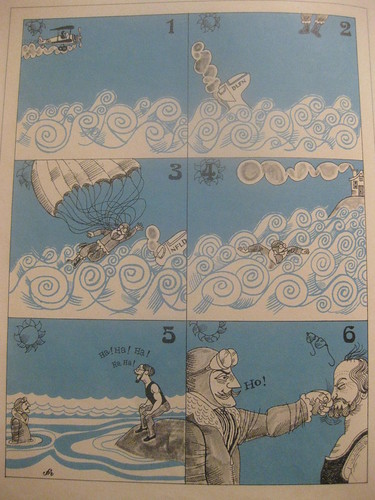
Pretty much exactly how I imagine the Lee/Newfeld relationship - from Garbage Delight, 1977.
March 23, 2011
So What Is the Bookseller For?
Last week I got all hysterical about the ebook market, so this week I thought I’d talk myself back to earth to some degree.
I am not, and will never be, an ebook convert, but as Joe Konrath and Barry Eisler point out in this rather widely circulated interview, some people will always prefer the paper product and that’s okay: there ought to be a niche market for that. And there will, no doubt. After all, even within the paper book market there’s great a variety of technologies and processes in use. You have publishing giants producing perfect-bound paperbacks for cheap and disposable use (like Bantam), literary presses producing nice books for a global market (like Anansi), artisanal presses producing for the smaller trade market (like Gaspereau), and private craft presses who produce books using every technology ever known to man, from hand-crafted papers to letterpresses to calligraphy (like the Aliquando Press). The existence of Bantam hasn’t made a scrap of difference to Aliquando, even if they offer more books at a fraction of the cost. It’s a different market.
But to say that books of both kinds can live happily side by side is not to say that all will be well in the world of a book-lover, and it certainly means not all will be well for the bookseller. Our market is most likely going to evaporate. Bookstores who specialize in the first two types of books – mass market fiction and literary fiction – are likely to vanish first, as these are the texts which appeal most to “just readers” who don’t care as much about whether paper is involved or not. Booksellers who have a more narrow focus or specialty might fare better. A customer looking to contribute to a library of, say, books on architecture for reference in his firm is not going to be very well served by an eReader, especially not the current grey scale, small-screen ones. And there’s always the Collector.
This leaves the bookseller in a tight spot. You might be lucky enough to be a niche seller anyway. You might also, as some American independents are trying to do, diversify your business into ebooks. You might see if the big ebook providers are hiring buyers – after all, someone still needs to sift through publishing (or self-publishing)’s offerings and decide what to put on the front page of the website. (Though I even question the necessity of the buyer in the digital world – why not carry everything? Who needs discrimination? Space isn’t a factor anymore, and search engines hide from view everything that isn’t what you asked for anyway!) Would it be worth the rent to have a video-store-style bookshop, with bookcovers and tags in display, redeemable for ebooks at the cash register? Would the presence of a bookseller – someone to recommend and to consult – pay for the costs associated with meat-space?
I think it’s a fair assessment to say that tomorrow’s print-booksellers will become like today’s rare book sellers. They are out there, and some make a very good living. But they are as scarce as their product, and in big, expensive cities like Toronto often don’t feel they need to keep an actual open shop when a den and an internet connection does just as well.
I do wonder what I will be doing in ten years. My bookstore is niche, to some extent, so the realities of ebooks haven’t touched us yet. We have a customer base who are, often, buying books to build libraries rather than to read casually. We don’t deal with front-list fiction, except in so far as we feel like dabbling in it for our own sakes. Our best-selling publishers (university presses) produce books of a high physical caliber at a higher cost, which has never been a deterrent to sales. We’re doing pretty well these days. But can it last forever?
It has occurred to me that what I’m doing with all my print-book advocacy and paranoid blogging is promoting the product which I know my livelihood hangs on. I sell print books now, and I will still be selling them, with any luck, in ten years. The size of the market I am selling into, and thus my chance of staying in the business long-term, depends on how well I can sell you guys on the value of the printed book. I know, and I have always known, that ebooks are a great product for a certain kind of reading. But those books aren’t my product, nor my interest. I do something different, and would like to continue doing what I do.
So that’s my position, but I wonder about yours! Many of this blog’s readers are front-list fiction readers rather than collectors, and publishing industry employees too. A lot of you have eReaders and are reconciled to, if not happily accepting of, the ebook revolution. But you are also lovers and supporters of independent bookstores. I wonder, how do you see yourself reconciling those two stances? What is your ideal relationship with the independent bookseller when you have an eReader? What services to they provide you that you’d pay the premium for?
March 23, 2011
This is pretty much what I’ve been on about.
“So thequestion isn’t, “Will paper disappear?” Of course it won’t, but that’s not what matters. What matters is that paper is being marginalized. Did firearms eliminate the bow and arrow? No–some enthusiasts still hunt with a bow. Did the automobile eliminate the horse and buggy? No–I can still get a buggy ride around Central Park if I want… Paper won’t disappear, but that’s not the point. The point is, paper will become a niche while digital will become the norm.“
March 22, 2011
A Bookish Investment Opportunity – RPGs?!
Confession time! I love role playing. No, not in the naughty way, I mean sitting around a table with a bunch of my collaborators and pretending we’re other people for hours at a time. Dice may be thrown. Accents may be donned. We’ve generally moved beyond Dungeons & Dragons, but the love of collaborative storytelling remains.
What can I say? I’ve always been a nerd.
 Table-top role players have always been closeted book collectors. It comes at them from two directions: first of all, they love props and visual representations of their imagined worlds, and the “leather-bound tome” is a favourite. The cover of role playing’s flagship text, the Player’s Handbook for Dungeons & Dragons 3rd Edition is mocked up with clasps and inlaid jewels, aping a decadent binding. Unsurprisingly, an actual leather-bound special edition followed the release of the game.
Table-top role players have always been closeted book collectors. It comes at them from two directions: first of all, they love props and visual representations of their imagined worlds, and the “leather-bound tome” is a favourite. The cover of role playing’s flagship text, the Player’s Handbook for Dungeons & Dragons 3rd Edition is mocked up with clasps and inlaid jewels, aping a decadent binding. Unsurprisingly, an actual leather-bound special edition followed the release of the game.
Secondly, role players have a tendency to be, shall we say, cautious about the condition of their books. We’re an obsessive lot. My husband won’t let anyone use his books as a hard surface to write on, for fear of indentations from the stylus marking his book. I know many people who keep two copies of their favourite manuals – one to be handled by their hands alone, and another for sharing. A friend of ours famously required interested parties to wash their hands before browsing his collection. And these are people who do not consider themselves book collectors.
So I shouldn’t have been surprised to find that there’s a very pricey market out there for used, out of print and rare role playing books. Considering most potential buyers are actually buying these books for use, not investment or collection, this is a bit stunning. The market exists almost exclusively on eBay, as book dealers don’t seem to have caught on. It’s an independent rare book market.
 I discovered the market the hard way – trying to buy a book. The 7th Sea Player’s Guide has only been out of print since let’s say about 2005, and you’d think everyone who wanted to play then would have a copy already. Alas, mine was lost due to my very liberal book-loaning policies, and I needed a replacement. I got a deal – I found a replacement copy for a mere $80. The going rate is closer to $90-100. Not bad for a book that was $30 only six years ago.
I discovered the market the hard way – trying to buy a book. The 7th Sea Player’s Guide has only been out of print since let’s say about 2005, and you’d think everyone who wanted to play then would have a copy already. Alas, mine was lost due to my very liberal book-loaning policies, and I needed a replacement. I got a deal – I found a replacement copy for a mere $80. The going rate is closer to $90-100. Not bad for a book that was $30 only six years ago.
 This prompted me to look up the going rate for a book I already owned, the Game of Thrones Deluxe Limited Edition guide. This was a Christmas present to my husband years ago, one which didn’t arrive until nearly a year after that Christmas. Production problems plagued the publication and the company went out of business shortly after – or was it shortly before? – the game was actually released. They honoured their pre-orders, but nothing beyond the original printing of either the limited edition or the standard edition was ever printed. Now, given the popularity of the novels the game is based on, and the upcoming HBO TV series, copies of this book are going for $250-$600.
This prompted me to look up the going rate for a book I already owned, the Game of Thrones Deluxe Limited Edition guide. This was a Christmas present to my husband years ago, one which didn’t arrive until nearly a year after that Christmas. Production problems plagued the publication and the company went out of business shortly after – or was it shortly before? – the game was actually released. They honoured their pre-orders, but nothing beyond the original printing of either the limited edition or the standard edition was ever printed. Now, given the popularity of the novels the game is based on, and the upcoming HBO TV series, copies of this book are going for $250-$600.
 Which brings me to my Once Upon a Time book. Once Upon a Time, a company called Last Unicorn Games was set to publish a role playing game based on Frank Herbert’s Dune universe. As many as 3,000 copies were printed by Last Unicorn to be released at GenCon, the big North American gaming convention. But shortly before the convention Last Unicorn was bought up by RPG giant Wizards of the Coast (who publish Dungeons and Dragons; and who are owned ultimately by toy-maker Hasbro). Rumours circulated that this meant a newer, even bigger version of the Dune game would be published under the WotC banner, but in reality nothing was ever heard from the game ever again. Those GenCon copies were the only ones to ever see the light of day. (There are also rumours that much of the original 3,000 copy print run was pulped.) Today’s price? Ha! That would assume you can actually buy it. If one is lucky enough to find one on eBay or Amazon, you will probably be paying $500-$600 for it. But don’t count on one.
Which brings me to my Once Upon a Time book. Once Upon a Time, a company called Last Unicorn Games was set to publish a role playing game based on Frank Herbert’s Dune universe. As many as 3,000 copies were printed by Last Unicorn to be released at GenCon, the big North American gaming convention. But shortly before the convention Last Unicorn was bought up by RPG giant Wizards of the Coast (who publish Dungeons and Dragons; and who are owned ultimately by toy-maker Hasbro). Rumours circulated that this meant a newer, even bigger version of the Dune game would be published under the WotC banner, but in reality nothing was ever heard from the game ever again. Those GenCon copies were the only ones to ever see the light of day. (There are also rumours that much of the original 3,000 copy print run was pulped.) Today’s price? Ha! That would assume you can actually buy it. If one is lucky enough to find one on eBay or Amazon, you will probably be paying $500-$600 for it. But don’t count on one.
It’s enough to make a girl hesitant to use her books in a game! Or to take up book scouting…
